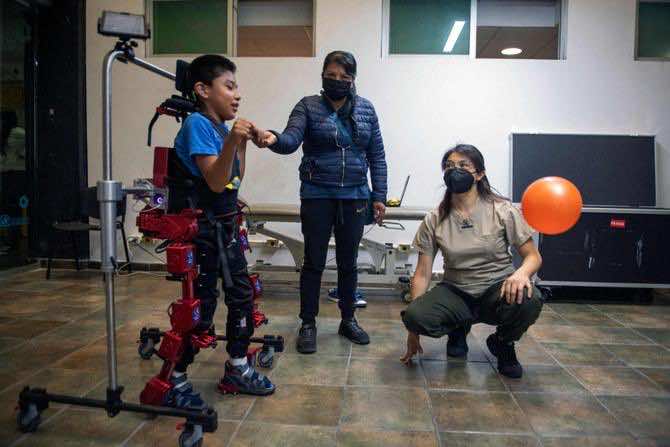An eight-year-old boy with cerebral palsy went through a therapy room in Mexico City wearing a robotic exoskeleton explicitly created for children, smiling triumphantly at the once-unthinkable feat.
David Zabala is wheelchair-bound due to a neurological disease that has rendered him deaf and dependent on sign language.
He could walk and stand in front of a mirror while drawing smiling faces with coloured marker pens owing to the Atlas 2030 exoskeleton, which received its developer a European Inventor Award this year.
“He’s taking his first steps. That’s a joy for him,” said the boy’s mother, Guadalupe Cardoso, 41.
“At first, it scared him, and his hands were very tense, and now I see that he’s already holding the marker pen and starting to draw or (play with) the ball,” Cardoso added.
It makes the difficult, nearly two-hour drive from their home in Mexico City’s south to the therapy centre worthwhile, she added.
Elena Garcia Armada, a Spanish professor, created the exoskeleton to allow children in wheelchairs to walk during muscular rehabilitation therapy.
According to the European Patent Office, which awarded Garcia the European Inventor Award, the mechanical joints of the battery-powered titanium suit adapt intelligently to the action of each child.
After Spain and France, Mexico is the third country where the Atlas 2030 has been utilised to treat children. According to Guadalupe Maldonado, director of Mexico’s Association for People with Cerebral Palsy, the suit helps “to achieve in record time rehabilitation goals” that would take months to achieve with conventional treatments.
According to Maldonado, the benefits include muscle strengthening, digestive and respiratory system improvement, and, most importantly, a significant mood boost. She claims that the private group, founded in 1970, has already noticed important outcomes two weeks after receiving its first exoskeleton.
The association’s initial goal is to provide rehabilitative services to about 200 children with cerebral palsy.
“We want to continue working and empowering so that more children in the city and the country have access to this type of rehabilitation… that radically changes their lives,” Maldonado said.

